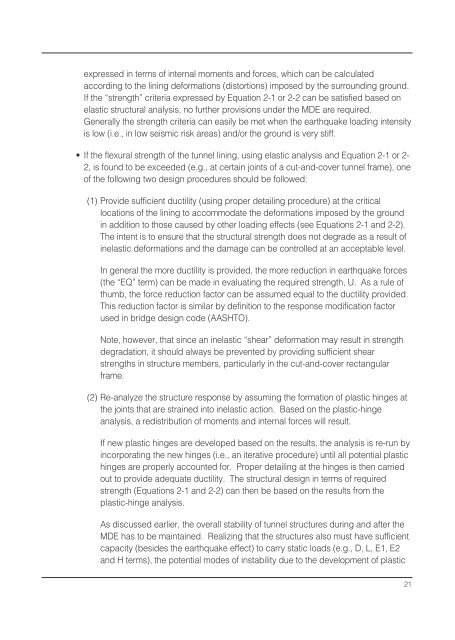Seismic Design of Tunnels - Parsons Brinckerhoff
Seismic Design of Tunnels - Parsons Brinckerhoff
Seismic Design of Tunnels - Parsons Brinckerhoff
You also want an ePaper? Increase the reach of your titles
YUMPU automatically turns print PDFs into web optimized ePapers that Google loves.
expressed in terms <strong>of</strong> internal moments and forces, which can be calculated<br />
according to the lining deformations (distortions) imposed by the surrounding ground.<br />
If the “strength” criteria expressed by Equation 2-1 or 2-2 can be satisfied based on<br />
elastic structural analysis, no further provisions under the MDE are required.<br />
Generally the strength criteria can easily be met when the earthquake loading intensity<br />
is low (i.e., in low seismic risk areas) and/or the ground is very stiff.<br />
• If the flexural strength <strong>of</strong> the tunnel lining, using elastic analysis and Equation 2-1 or 2-<br />
2, is found to be exceeded (e.g., at certain joints <strong>of</strong> a cut-and-cover tunnel frame), one<br />
<strong>of</strong> the following two design procedures should be followed:<br />
(1) Provide sufficient ductility (using proper detailing procedure) at the critical<br />
locations <strong>of</strong> the lining to accommodate the deformations imposed by the ground<br />
in addition to those caused by other loading effects (see Equations 2-1 and 2-2).<br />
The intent is to ensure that the structural strength does not degrade as a result <strong>of</strong><br />
inelastic deformations and the damage can be controlled at an acceptable level.<br />
In general the more ductility is provided, the more reduction in earthquake forces<br />
(the “EQ” term) can be made in evaluating the required strength, U. As a rule <strong>of</strong><br />
thumb, the force reduction factor can be assumed equal to the ductility provided.<br />
This reduction factor is similar by definition to the response modification factor<br />
used in bridge design code (AASHTO).<br />
Note, however, that since an inelastic “shear” deformation may result in strength<br />
degradation, it should always be prevented by providing sufficient shear<br />
strengths in structure members, particularly in the cut-and-cover rectangular<br />
frame.<br />
(2) Re-analyze the structure response by assuming the formation <strong>of</strong> plastic hinges at<br />
the joints that are strained into inelastic action. Based on the plastic-hinge<br />
analysis, a redistribution <strong>of</strong> moments and internal forces will result.<br />
If new plastic hinges are developed based on the results, the analysis is re-run by<br />
incorporating the new hinges (i.e., an iterative procedure) until all potential plastic<br />
hinges are properly accounted for. Proper detailing at the hinges is then carried<br />
out to provide adequate ductility. The structural design in terms <strong>of</strong> required<br />
strength (Equations 2-1 and 2-2) can then be based on the results from the<br />
plastic-hinge analysis.<br />
As discussed earlier, the overall stability <strong>of</strong> tunnel structures during and after the<br />
MDE has to be maintained. Realizing that the structures also must have sufficient<br />
capacity (besides the earthquake effect) to carry static loads (e.g., D, L, E1, E2<br />
and H terms), the potential modes <strong>of</strong> instability due to the development <strong>of</strong> plastic<br />
21
















